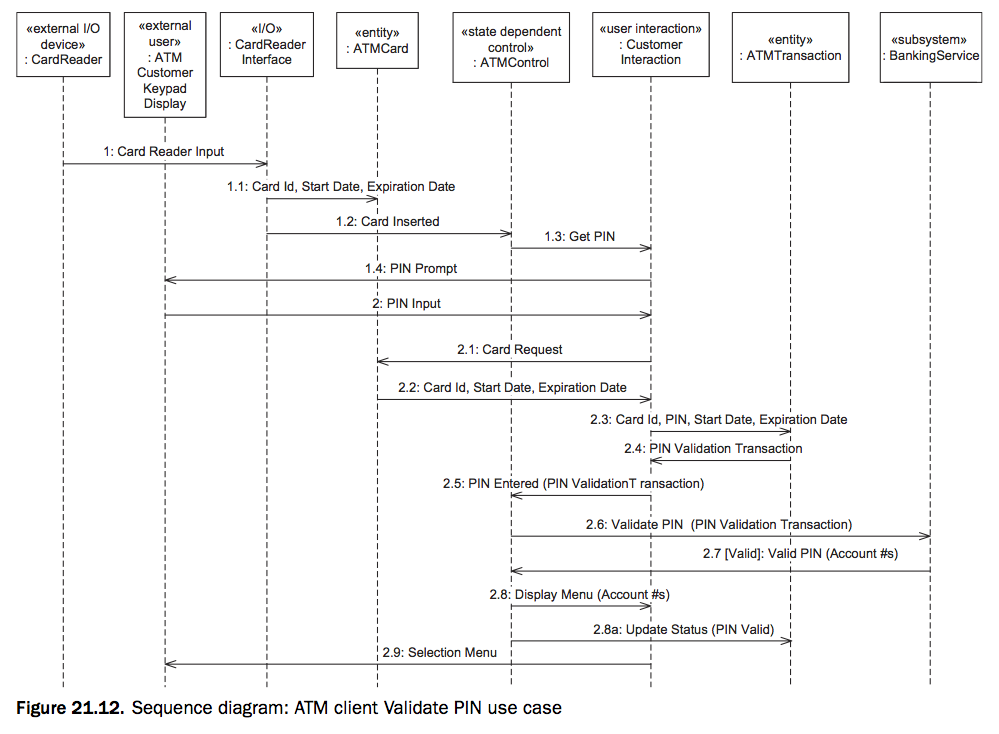Contents
- Introduction to Software Engineering
- Software Development Life Cycle
- Agile Software Development
- Disciplined Agile Delivery
- ...


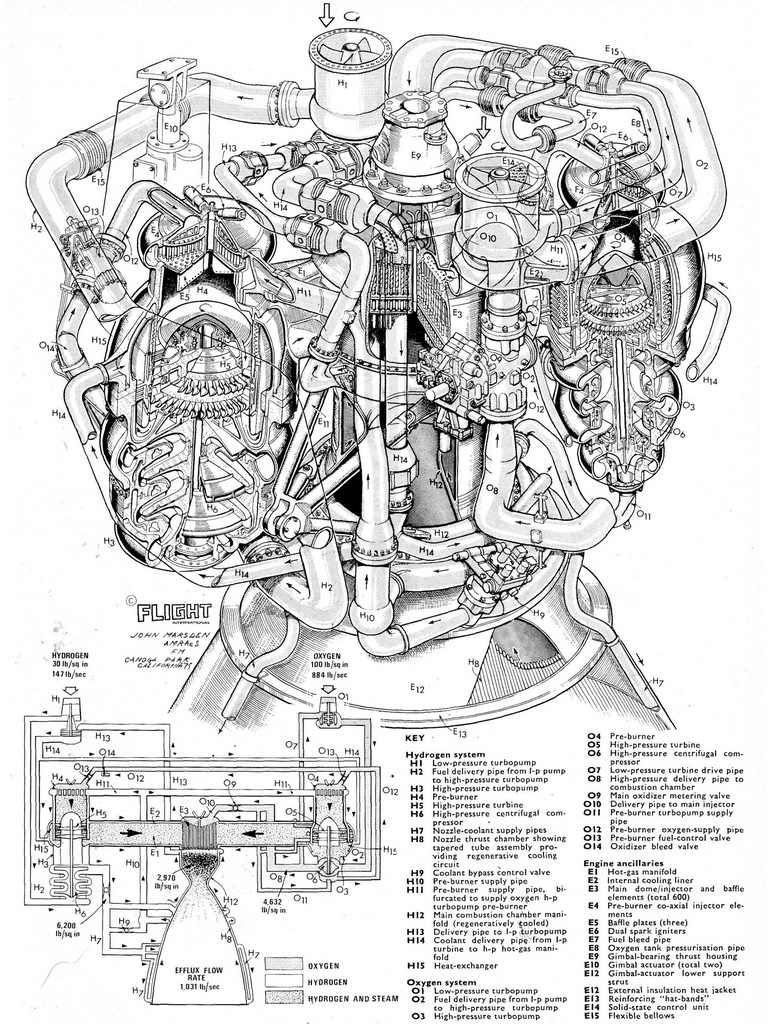
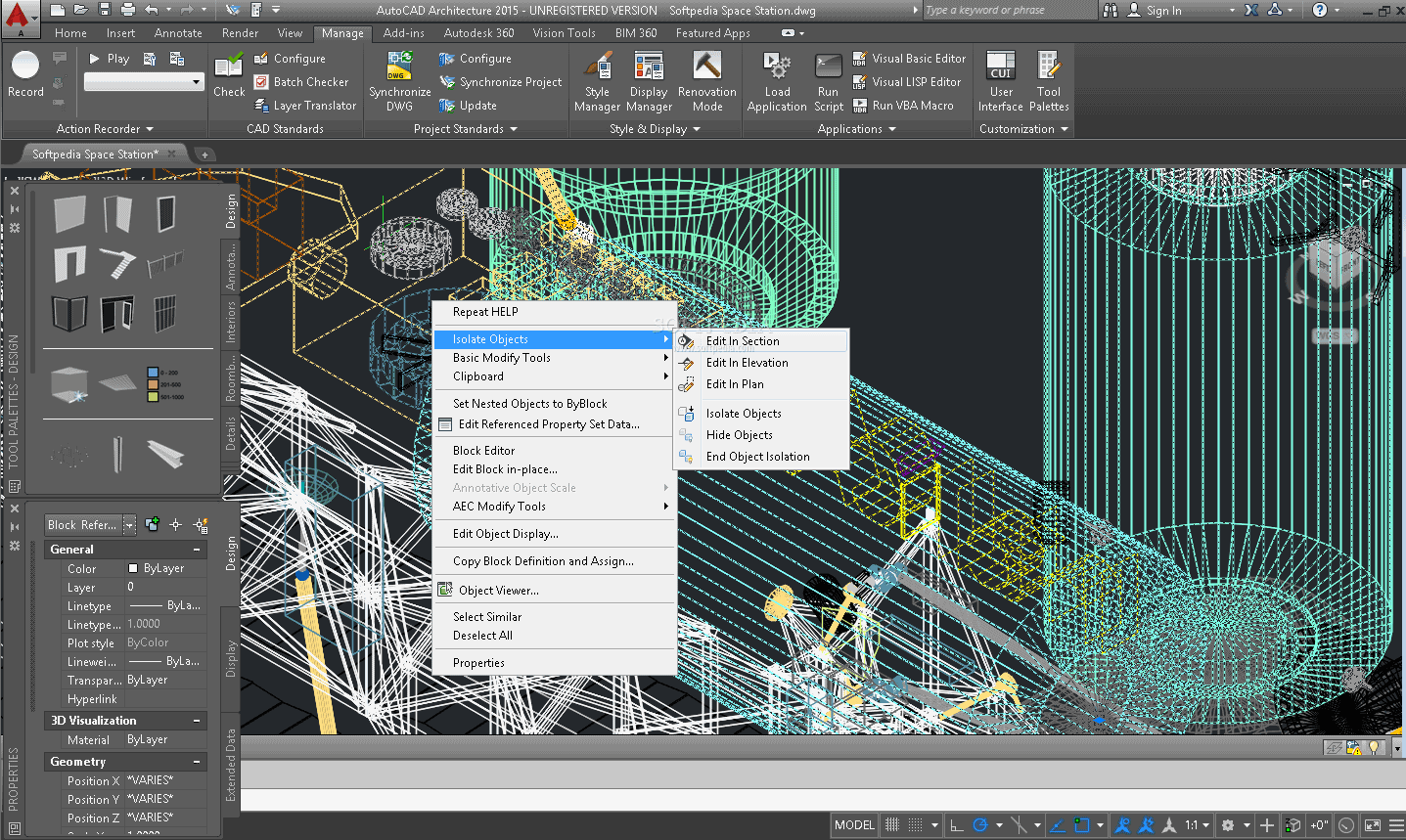
Structural Engineering Topics
- Soil Mechanics
- Structural Mechanics
- Hydraulics and Hydrology
- Codes and Construction
- Risk management, uncertainty
- Project Planning & Scheduling
- Cost estimating
- Activity identification and sequencing
Software Engineering Topics
- Programming Languages
- Data structures, algorithms & complexity
- Operating Systems, Networking, Database, ...
- Object oriented design
- Systems architecture
- ??
Procedures, Processes, Methodologies, Practices
DOD SE Process Model (2008)

DOD Systems Software Development (1988)
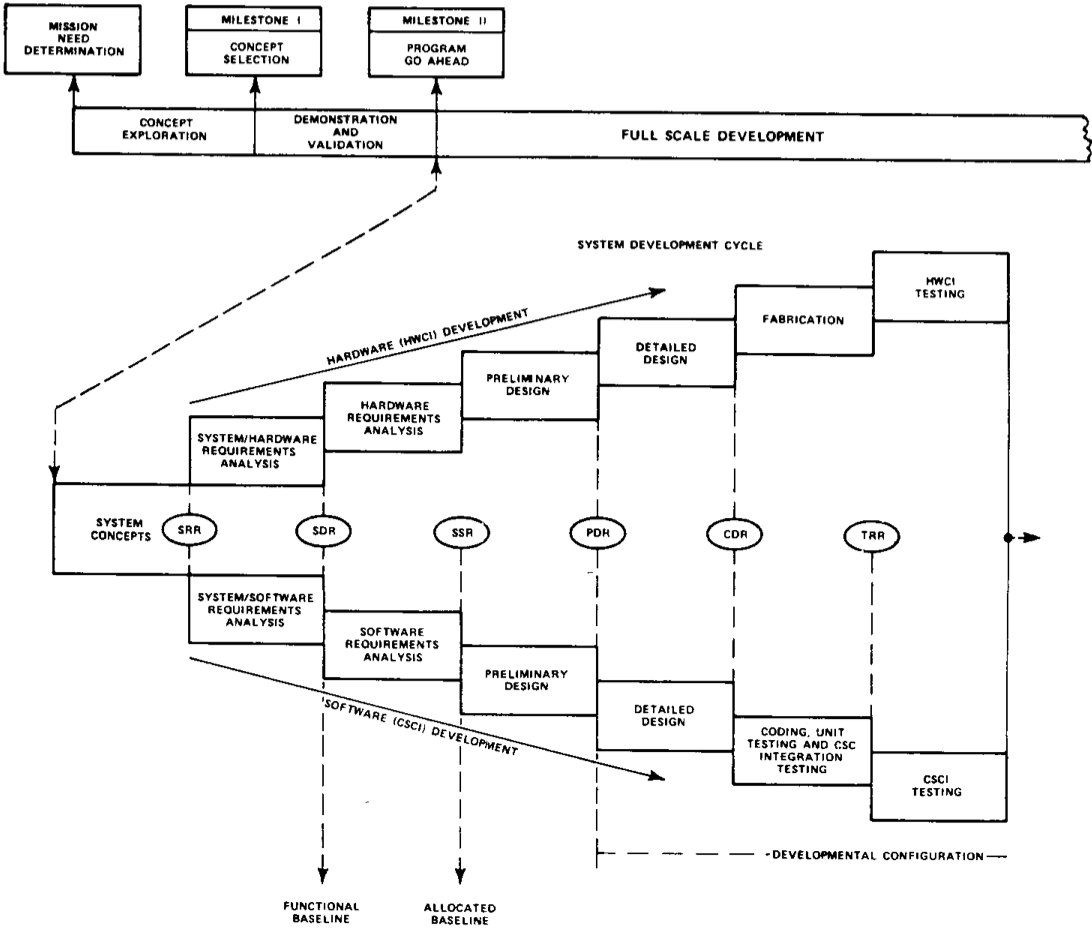
Waterfall Model
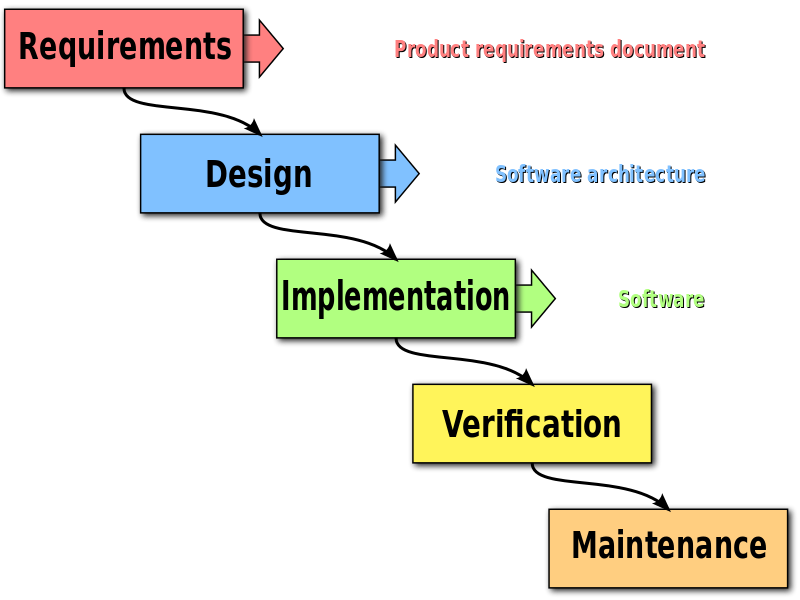
Core Processes
- Software Requirements (Elicitation, Analysis, Specification, Validation)
- Software Design (including: Architecture, UI)
- Software Construction
- Software Testing
- Software Maintenance
Related Processes
- Software Configuration Management
- Software Engineering Management
- Software Engineering Process
- Software Engineering Modeling
- Software Quality
- Software Engineering Professional Practice
- Software Engineering Economics
- Computing and Mathematical Foundations
SWEBOK
Software Engineering Book of Knowledge, Vol. 3
SWEBOKv3.pdf (local copy)
Requirements Analysis
“Software requirements express the needs and constraints placed on a software product that contribute to the solution of some real-world problem. ... It is widely acknowledged amongst researchers and industry practitioners that software projects are critically vulnerable when the requirements- related activities are poorly performed”
Software Design
Both the process of defining the architecture, components, interfaces, etc. and the result of that process. “during software design, software engineers produce various models that form a kind of blueprint of the solution to be implemented. We can analyze and evaluate these models to determine whether or not they will allow us to fullfill the various requirements.”
Software Construction
“the detailed creation of working software through a combination of coding, verification, unit testing, integration testing, and debugging ... much design work is performed during the construction activity.”
Software Testing
“the dynamic verification that a program provides expected behaviors on a finite set of test cases, suitably selected from the usually infinite execution domain. Can also imply static testing.”
Software Maintenance
“all the activities required to provide cost-effective support to (previously delivered) software.”
“software products change or evolve ... once in operation, defects are uncovered, operating environments change and new user requirements surface.” These must be covered by software maintenance.
SDLC
- Waterfall
- Spiral
- Prototyping
- RAD
- DSDM
- Agile
- XP
- Scrum
- RUP
- DAD
- ...
Criticims of Waterfall
Cost of Change
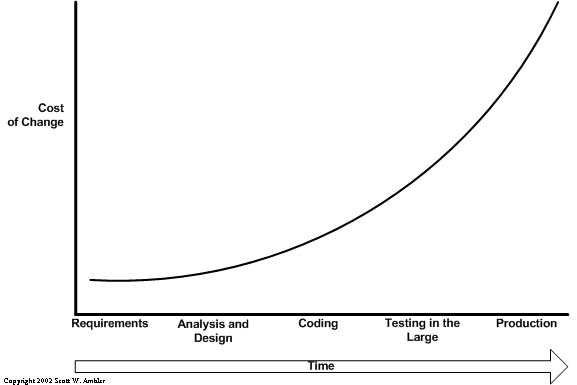
- Unknowns
- Uncertainty
- Risk
- Changes
- Software engineering isn't linear
- Creation of software is often a creative process
Rise of Agile
Disciplined Agile Delivery
“The Disciplined Agile Delivery (DAD) process framework is a people-first, learning-oriented hybrid agile approach to IT solution delivery. It has a risk-value lifecycle, is goal-driven, is scalable and is enterprise aware.”
DAD
- People first
- Learning oriented
- Agile
- Hybrid
- IT solution focused
- Goal-driven
- Delivery focused
- Enterprise aware
- Risk and value driven
- Scalable
DAD Lifecycle
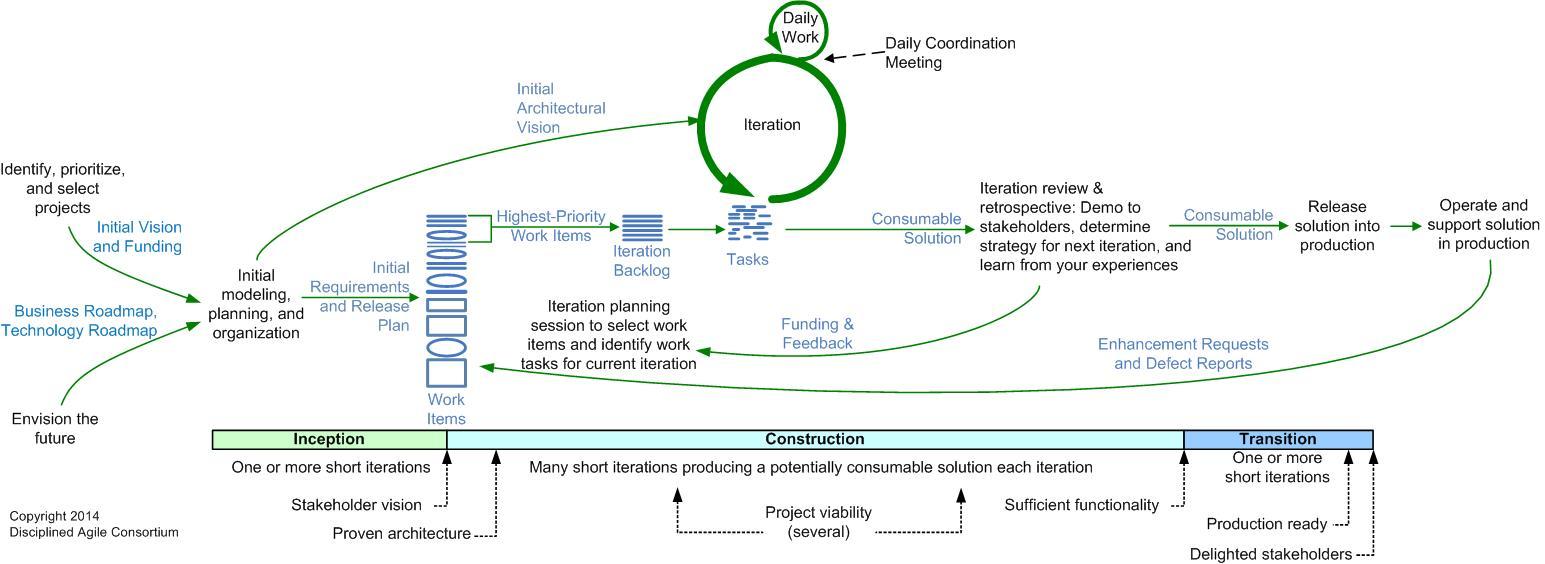
Goals

Disciplined Agile Principles
- Our highest priority is to satisfy the stakeholder through early and continuous delivery of valuable solutions.
- Welcome changing requirements, even late in the solution delivery lifecycle. Agile processes harness change for the customer’s competitive advantage.
- Deliver consumable solutions frequently, from a couple of weeks to a couple of months, with a preference to the shorter time scale.
- Stakeholders and developers must work together daily throughout the project.
- Build teams around motivated individuals. Give them the environment and support they need, and trust them to get the job done.
- The most efficient and effective method of conveying information to and within a delivery team is face-to-face conversation.
- Consumable solutions are the primary measure of progress.
- Agile processes promote sustainable delivery. The sponsors, developers, and users should be able to maintain a constant pace indefinitely.
- Continuous attention to technical excellence and good design enhances agility.
- Simplicity – the art of maximizing the amount of work not done – is essential.
- The best architectures, requirements, and designs emerge from self-organizing teams.
- At regular intervals, the team reflects on how to become more effective, then tunes and adjusts its behavior accordingly.
- Leverage and evolve the assets within your enterprise, collaborating with the people responsible for those assets to do so.
- Visualize work to produce a smooth delivery flow and keep work-in-progress (WIP) to a minimum.
- Evolve the enterprise to support agile, non-agile, and hybrid teams.
Lean Principles
- Eliminate waste; build in quality
- Create knowledge; defer commitment
- Deliver quickly; respect people
- Optimize the whole; visualize workflow
- Limit work-in-progress (WIP)
Reality over Rhetoric
- Requirements evolve throughout the lifecycle although the initial scope should still be agreed to at the beginning of the project.
- Simple designs are best although the architecture should be thought out early in the lifecycle.
- Teams should be self-organizing although they are still constrained (and enhanced) by your organizational ecosystem
- Delivery teams don't need prescriptive process definitions although they do need some high-level guidance to help organize their work.
- Development professionals know what to do although they're still not process experts.
- Development professionals should validate their own work to the best of their abilities although they likely aren't testing experts so therefore need help picking up the appropriate skills.
- Disciplined agile teams work in an iterative manner although still follow a lifecycle that is serial over time.
Foundations of DAD
or ... all the things DAD has integrated
Agile Practices adopted by DAD
- Scrum
- Extreme Programming (XP)
- Agile Modeling
- Agile Data
- Lean software development
- IBM Practrices Library
- OpenUP
- + others
Scrum
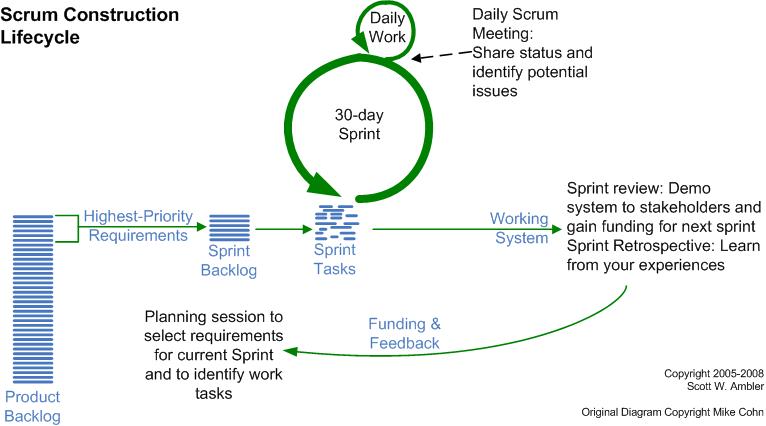
Scrum: key points for now
- Sprint-based (iterative, time-boxed)
- “Deliver potentially shippable software at the end of each sprint”
- User story based
Extreme Programming (XP)
Take the good things to extremes
- Coding guidelines and standards
- Code transparency
- Continuous integration
- Test Driven Development (TDD)
- Code Refactoring
- Pair programming
- Principles: Feedback -- Simplicity -- Embrace change
Agile Modeling
Methodology for effective modeling and documentation
- “Just enough modeling; just barely good enough” (KISS)
- Modeling at all phases of construction; model storming
- Document continuously, but late
- Executable specifications: executable customer tests
- Test Driven Development
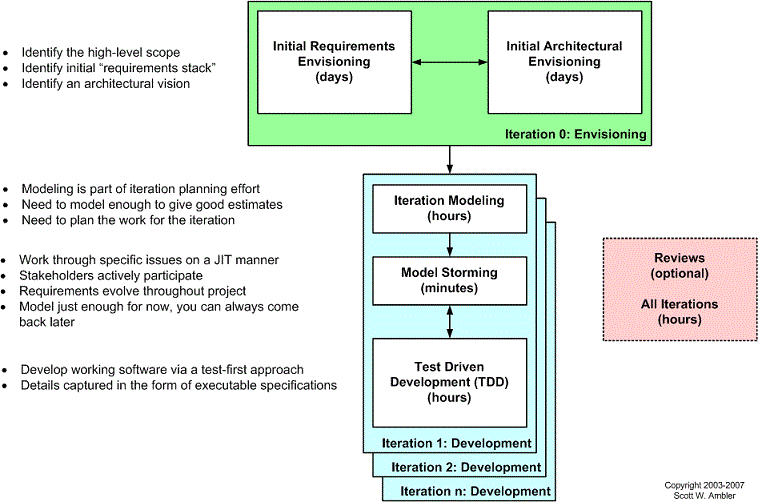
Agile Data
Agile methods to work effectively with the data aspects your project
- Database refactoring: evolutionary improvement of dB schema
- Agile Data modeling for the dB
- DB regression testing
- Configuration management of data
- Developer sandboxes
Lean Software Development
Lean thinking applied to software development
- Eliminate waste
- Amplify learning
- Delay decisions
- Deliver fast, frequent delivery
- Find good people and let them work
Open Unified Process
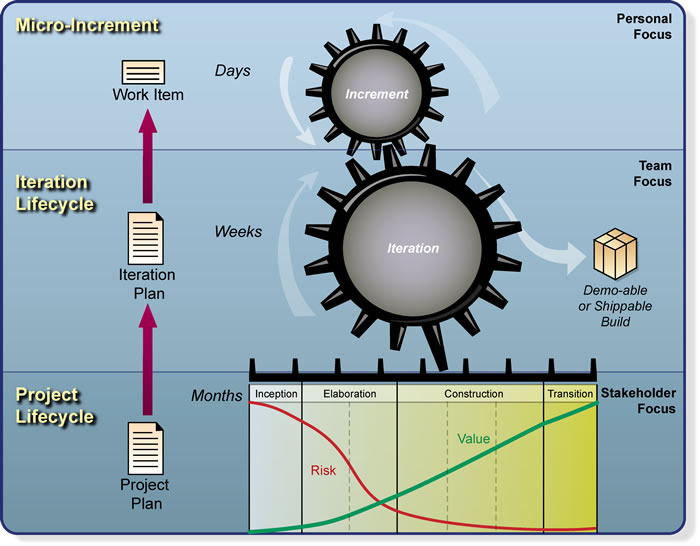
Roles, Rights & Responsibilities
“People build solutions -- not processes, not tools, not practices -- people.”
Individuals and interactions over processes and tools.
- role
- a part that you play within a given situation. Includes stakeholders, team leads, team members, ...
- right
- something to which you have just claim
- responsibility
- an obligation that you have to someone else
Rights of Everyone
Responsibilities of Everyone
Roles
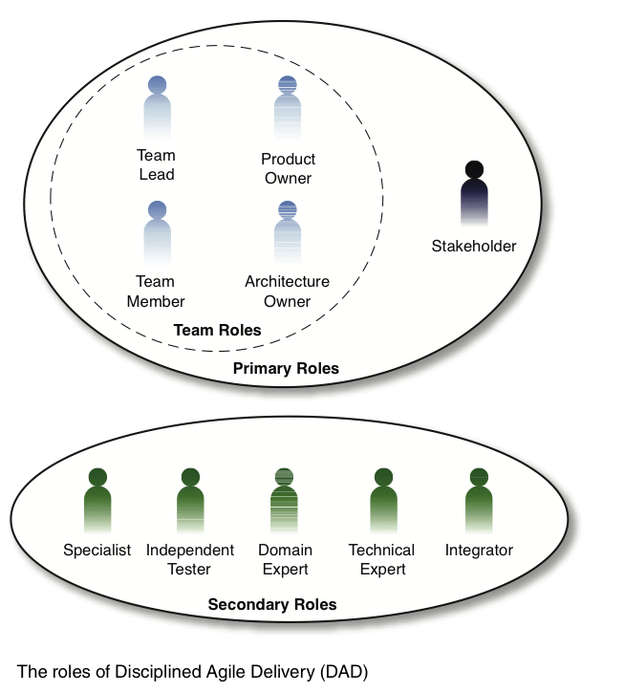
Stakeholder
- End users
- Principals
- Partners
- Insiders
Product Owner
“the one voice of the customer”, the stakeholder proxy
Team Member
Produces the actual solution for stakeholders: developers, programmers, ...
Team Lead
Team facilitator, guide, servant-leader, agile coach (ScrumMaster).
NOT: boss, manager or project manager
Remember: agile teams are self-organizing
Architecture Owner
Owns architecture decisions, facilitates creation and evolution of the overall solution design. Often the senior developer.
Inception
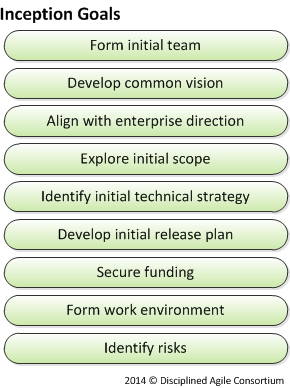
Typical Approach
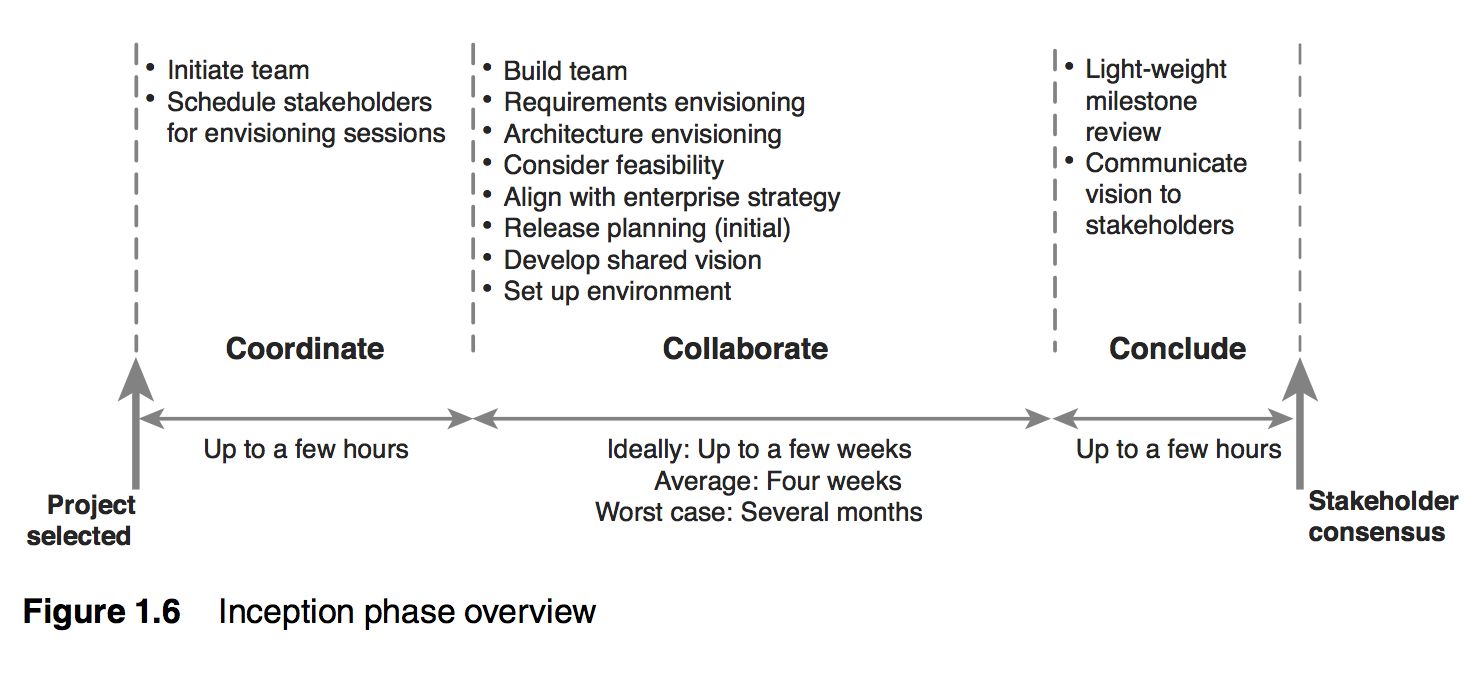
Example Inception Phase Order
- Requirements envisioning
- Architecture envisioning
- Set up environment(s)
- Review UI prototype
- Lots of everything
- Release planning
Patterns for success
- Short and sufficient
- Ranged estimates
- Minimal but sufficient documentation
ANTI-Patterns for success
- No support for skills development
- No support for dedicated facilities
- Autocratic project management practices
- Jumping into construction
- Overly detailed work products
- Analysis paralysis
Project Vision
What's in a Vision?
- What are you going to produce?
- How long will it take?
- What will it cost?
- How are you going to build it?
- Do you understand the risks?
Vision Styles
- Detailed vision document/project charter/ business case (heavyweight, 20-50 pages)
- Lightweight vision statement (1-4 pages)
- Vision radiators
- Nothing at all
Bring Stakeholders to Agreement Around the Vision
The fundamental purpose of the Inception phase is to come to an agreement within your team and with your stakeholders regarding a strategy for the rest of the project.
=> Active stakeholder participation
=> Shared vision
Identifying the Initial Scope
Most agile teams do initial requirements modeling
- Answer fundamental business questions
- Improve productivity
- Reduced business risk
- Increased scalability
But only hours or days, not weeks or months No BRUF!
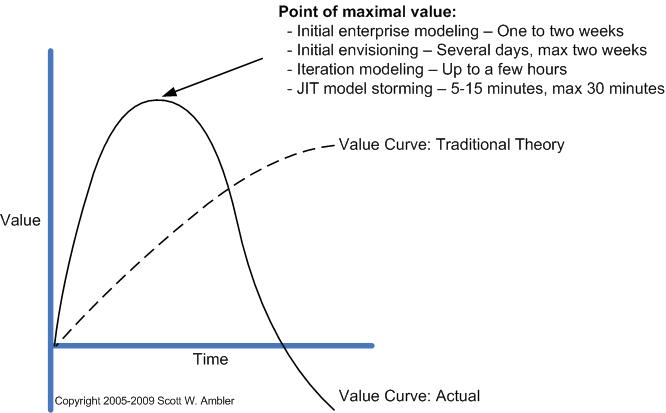
Modeling
- Use
- User stories
- Use case
- Usage scenarios
- Domain: Entities and Relationships
- ER or UML diagrams
- CRC cards
- UI
- Wireframes, Sketches & Diagrams
- Flow diagram
- Non-functional (Quality of Service, or technical) requirements
Choose Work Management Strategy
- Formal change management, change control board, change requests/tickets
- Scrum product backlog
- Work item stack
- Work item pool
- No strategy!
Nonfunctional Requirements
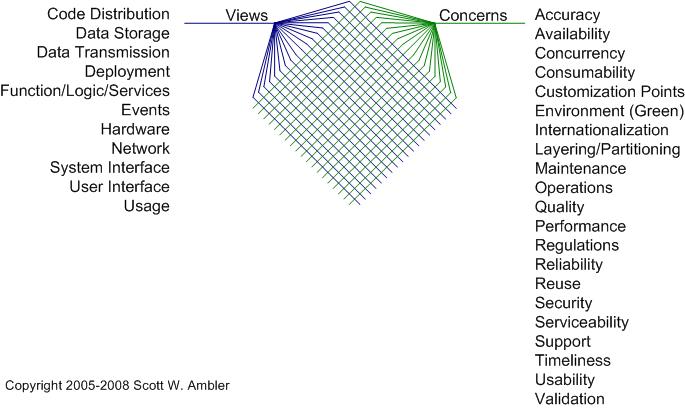
Strategies for NFR's
- Technical stories
- Acceptance criteria for individual functional requirements
- An explicit list
Initial Technical Strategy (Architecture)
Level of Detail
- Detailed end-to-end
- Detailed interface
- High-level overview
- None
Inception Phase Case Study
















User Stories
As a type of user, I want some goal so that some reason.
INVEST
(see Bill Wake)
- Independent
- Negotiable
- Valuable
- Estimable
- Small
- Testable
Inception Example
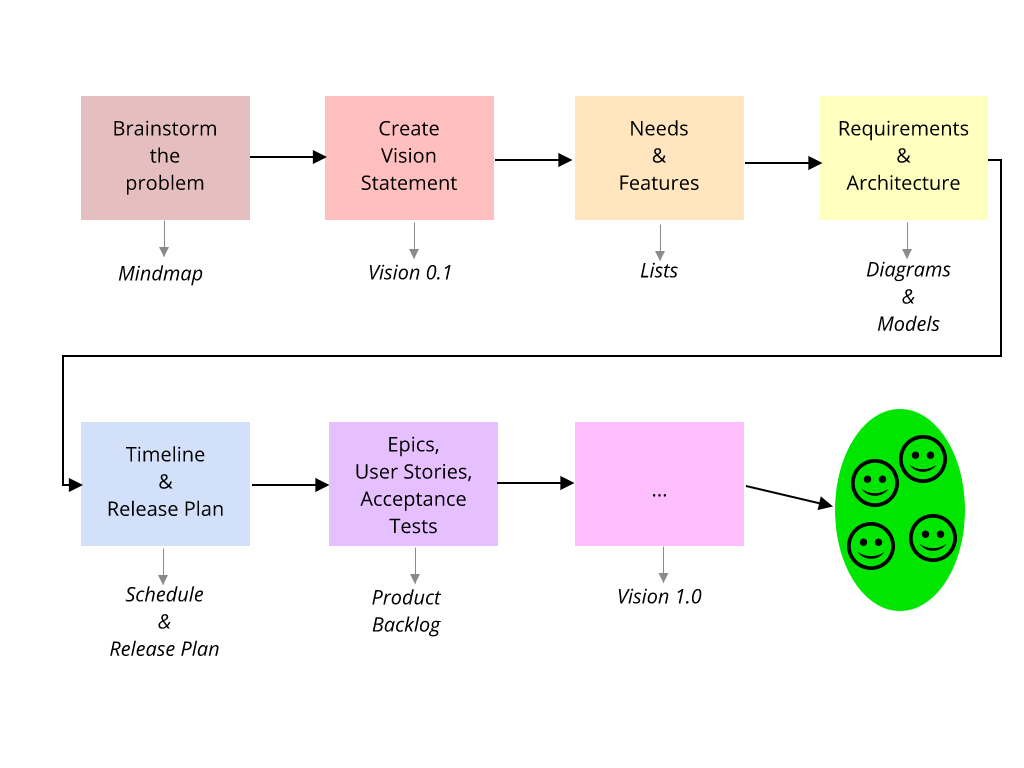
Vision Statement
Classical Software Requirements Elicitation and Modeling
Use Cases
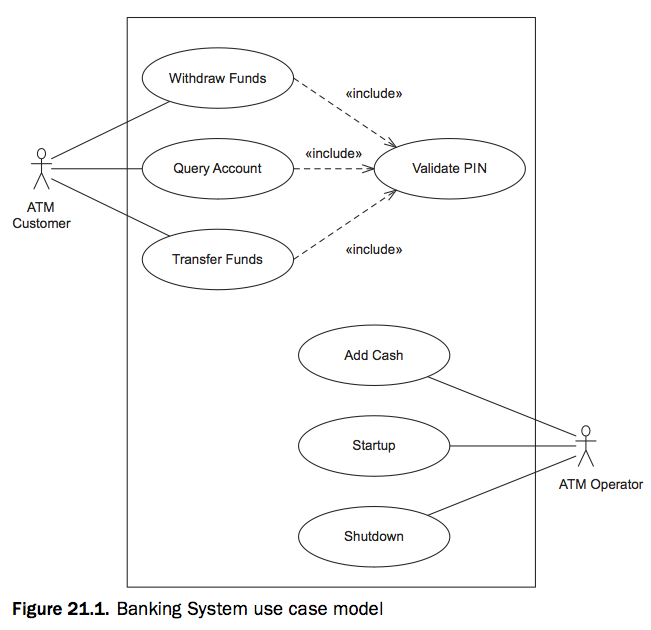
Software Modeling & Design, by Hassan Gomaa Ch. 21
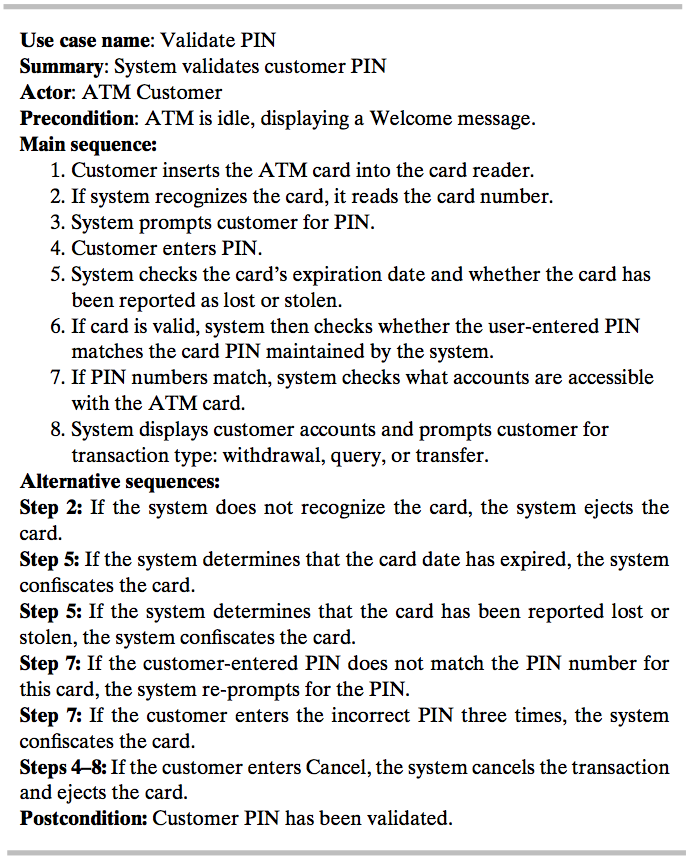
User Story vs. Use Case
Use Case
- Formal, UML specifications
- Heavyweight, prescribed documentation
- Attempt to define what systems are supposed to do; capture all requirements
- Actors, Systems, Interactions
User Story
- Lightweight; short descriptions
- Don't provide details needed to implement (which emerge organically later)
- Actor, Action, Achievement; focused on value
- Acceptance criteria
Use Cases can help with initial modeling
Some handwritten notes on UML: UML.pdf
Static Modeling
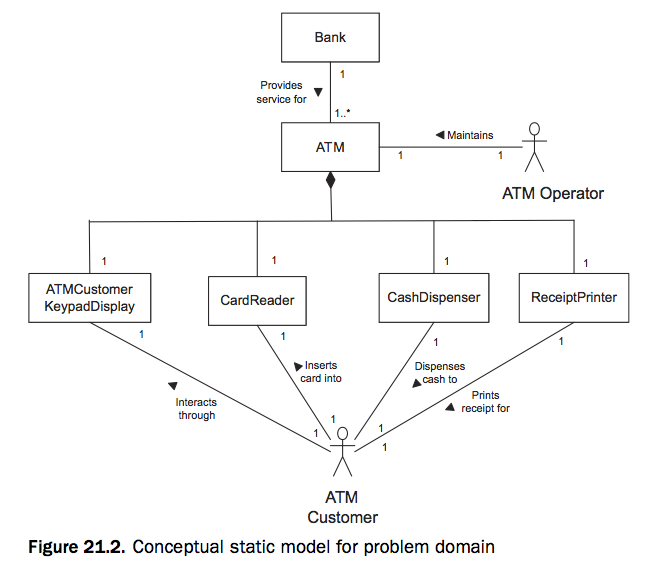
Conceptual Class Diagram
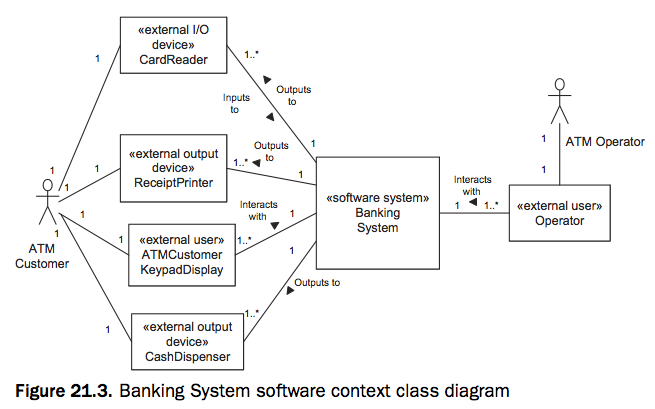
More Detailed Class Diagram
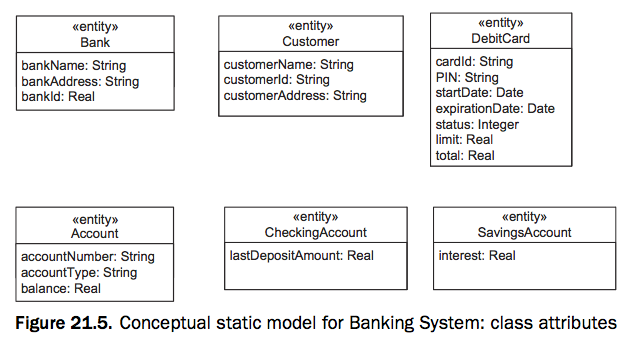
Dynamic Modeling
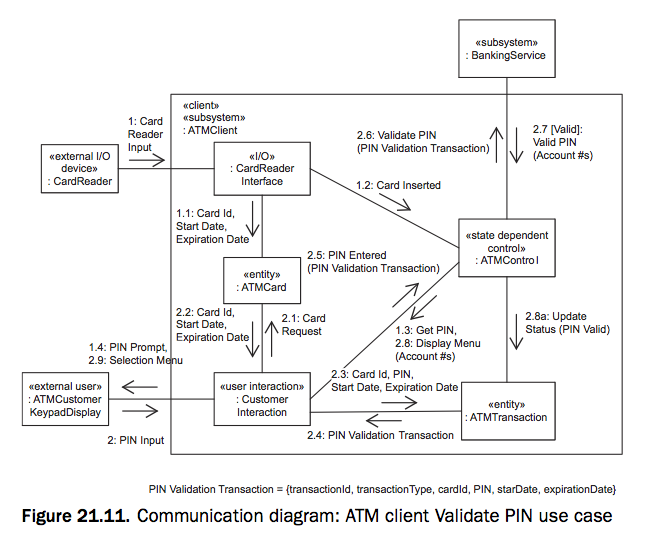
Sequence Diagram
